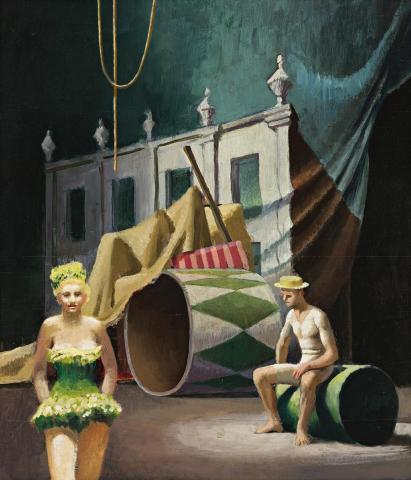BACKSTAGE, 1957
JEFFREY SMART
oil on board
41.0 x 35.5 cm
signed lower right: JEFFREY SMART
Estate of Howard Dowling , acquired in 1957
Charles Leski Auctions, Melbourne, 22 November 2004, lot 317
Private collection, Adelaide
Macquarie Galleries, Sydney, 12 – 4 June 1957, Cat. No. 10.
Quartermaine, P., Jeffrey Smart, Gryphon Books Pty Ltd, Melbourne, 1983, cat. 314, p. 106
A bare-footed man sits on a barrel, eyes downcast, a straw boater on his head. A woman in garish green looks impassively towards the front. Behind them, a painted backdrop of an austere Victorian building is coming loose from its support, revealing a blank black door. Cold white light falls from above and to the right. As viewers, we recognise each element but struggle to make a coherent narrative.
Jeffrey Smart has always been the master painter of such psychologically charged scenes since his earliest days as an artist. In Backstage, 1957, the results of his rigorous training under Ivor Hele and the renowned French artist Fernand Legér are clearly evident. 'If you want to be a realist painter, then obviously you must have some training in being able to depict and to learn the general tricks of the trade: making things lie down, making things sit up, putting volumes in space, anatomy, perspective - just the general sleight of hand, the trickery of making illusion.'1 Backstage also demonstrates the artist's fascination with, and clear understanding of, the effects of light 'catching or making new shapes.'2 Critics and viewers have often commented on an apparent world-weariness in Smart's characters, as if they were lost souls contemplating their own lack of meaning and/or power. Smart himself was ambivalent about such interpretations and averred that actors and performers often face the same difficulty an artist does when in pursuit of original artistic expression. 'An artist has to be like an actor in that he can take on that feeling, that mood, that thing.'3
At the time of the 1957 exhibition at Macquarie Galleries, Sydney, the artist and critic James Gleeson noted that Smart's work lay within the romantic tradition, conveying 'an inner drama, so intense that the external world becomes as unreal as paste-board props in an empty theatre. The performers are walking in their sleep while a building wrinkles into folds and turns into a curtain.'4 Smart clearly understood the surreality that may be witnessed in life, but was always cautious to remember that '(t)he subject matter is only the hinge that opens the door, the hook on which one hangs the coat. My only concern is putting the right shapes in the right colours in the right places. My main concern is always the geometry, the structure of the painting.'5 Backstage was exhibited alongside a suite of similarly themed canvases at Macquarie Galleries bearing such titles as Sideshow, Acrobats resting, Clown in the ruins, Master of the acrobats, and The jostlers, with the last work now in the collection of the Art Gallery of South Australia.
1. Smart, J., quoted in De Gruen, G., Some other dream: the artist, the artworld, and the expatriate, Hale & Ironmonger, Sydney, 1984, p. 58
2. Smart, J., op. cit., p. 54
3. Ibid., p. 50
4. Gleeson, J., 'Artist's tradition', The Sun, Sydney, June 1957
5. Smart, J., quoted in McGrath, S., 'Jeffrey Smart', Art and Australia, June 1969, p. 34
ANDREW GAYNOR
